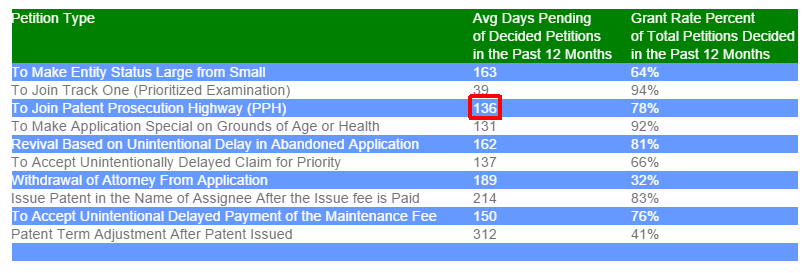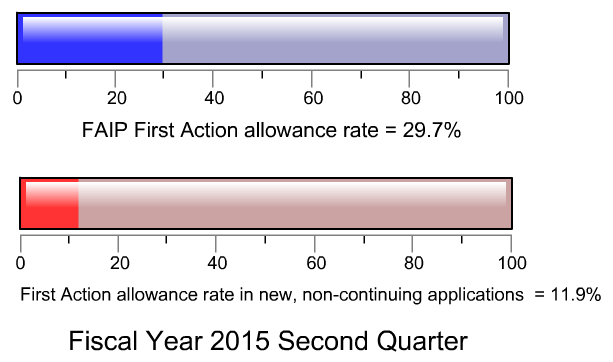As the new year approaches, a blogger’s thoughts reflect back on the past year. Which were the most popular Ant-Like Persistence blog articles of 2015? Continue reading “Most popular Ant-Like Persistence blog articles of 2015”
Will the USPTO be closed this Thursday?
Every December there is a sort of game of chicken, with federal employees (and customers of the USPTO) wondering until the last minute whether the President will sign an executive order giving federal employees an extra day off from work around Christmas. This affects customers of the USPTO because they need to know whether patent applications and responses can be postponed until the next working day.
Slightly over half of the time over the last twenty years or so, what has happened in December is that the President signs such an order. There has never been more than two or three weeks’ advance notice, and sometimes the Presidential order has been signed just a few days before the would-be holiday.
In 2014 Christmas fell on a Thursday (and thus was a federal holiday), and on December 5 of that year the President signed an order giving everybody an extra day off on Friday the 26th. This meant that any patent application or response that would normally be due on the 25th or 26th or 27th or 28th could be postponed until the 29th.
In 2013 Christmas fell on a Wednesday and the president did not give any extra time off.
So how will it be this Christmas season? Will federal employees get the day off on Thursday the 24th? Will customers of the USPTO be able to put off filings that would have been due on the 24th until Monday the 28th? Continue reading “Will the USPTO be closed this Thursday?”
PPH petition backlog worsens
The USPTO’s backlog of undecided PPH petitions seems to be getting worse. Continue reading “PPH petition backlog worsens”
Recent USPTO filing receipt delays
How long is it taking the USPTO these days to mail an official Filing Receipt? At our firm we try to track these things pretty closely, and here is how it looks lately. Continue reading “Recent USPTO filing receipt delays”
USPTO has broken the XML import feature of the ADS
(It took a couple of days, but USPTO did eventually acknowledge that it broke the XML import feature. See a followup post here.)
By way of background, for many years, since the first days of EFS-Web, it has been possible using Acrobat to import bib data from an XML file on the user’s hard drive into the Application Data Sheet (PDF) file such as Form PTO/AIA/14. The resulting PDF file could then be uploaded into EFS-Web.
Bruce Young, who is an alert member of the EFS-Web listserv, recently reported that when USPTO released version 2.1.12 of its Application Data Sheet PDF form, USPTO broke the XML import capability of the form. As Bruce explains:
Older versions of the ADS form, up to and including 2.2.11 (number in lower left corner of the form) allowed an .xml file to be imported into the form to populate it. … I use this feature because my docketing system (AppColl) can create a .xml file with all of the correct information that I have entered into that system, so I don’t have a possibility of typos once the information has been correctly entered into my docketing system.
But [the new version of the PDF form] for some reason does not allow the importation of a .xml file. The menu option for Import Data is greyed out for some reason.
The unhappy consequence of this action by USPTO, breaking the import feature, is that users are forced to hand-key bib data into the PDF form. This increases the risk of a user completing the ADS form incorrectly.
USPTO should repair this form, re-enabling the XML import feature of the form.
Office of Patent Petitions still lagging with PPH petitions
The Office of Pate nt Petitions dashboard would have us believe that the present backlog for deciding PPH petitions is 136 days. Given that the factual requirements for such a petition are nowadays self-certified by the filer, it seems unreasonable that the filer should have to wait 136 days for the petition to be decided. Indeed it seems to me that USPTO should make this into an ePetition (the kind of petition that is automatically processed by EFS-Web and immediately granted, if all petition requirements are met).
nt Petitions dashboard would have us believe that the present backlog for deciding PPH petitions is 136 days. Given that the factual requirements for such a petition are nowadays self-certified by the filer, it seems unreasonable that the filer should have to wait 136 days for the petition to be decided. Indeed it seems to me that USPTO should make this into an ePetition (the kind of petition that is automatically processed by EFS-Web and immediately granted, if all petition requirements are met).
Some weeks ago a high-up person in the Office of Patent Petitions told me that Something Was Going To Be Done. Resources were going to be found, I was told, so that this backlog could be reduced. But my post today notes that one of our PPH cases had its petition filed 144 days ago and the Office of Patent Petitions has not yet gotten to that petition. Things seem to be getting worse, not better.
The policy goals of PPH (reducing examination backlog, improving patent quality, promoting science and the useful arts) are not well served when the USPTO falls so far behind (four, five, even six months of delay) in deciding PPH petitions.
No need for Extension of Time Petitions
A question came up the other day in the listserv for patent practitioners (EFS-Web). A list member asked how one should fill in the various fields in Form PTO/AIA/22 (Petition for Extension of Time). One of the fields is “FOR” and the list member wondered whether the title should be pasted into that field.
One thing about this is that in my view (see blog), no field other than the application number actually matters or is required. But more importantly, in my view Form PTO/AIA/22 (and its companion form PTO/SB/22) is completely unnecessary. Here’s why.
First Action Interview Pilot program might be a good choice for some applicants
The First Action Interview Pilot program (FAIP) is a way to try to get a patent faster. For some applicants it may be smart to use FAIP. USPTO’s patent dashboard claims that the first office action allowance rate for FAIP cases is 30%, while the corresponding statistic for non-FAIP cases is 12%. This suggests that an applicant might be smart to try FAIP. In this blog post I will discuss some of the potential advantages and disadvantages of FAIP. Continue reading “First Action Interview Pilot program might be a good choice for some applicants”
USPTO’s patent dashboard claims that the first office action allowance rate for FAIP cases is 30%, while the corresponding statistic for non-FAIP cases is 12%. This suggests that an applicant might be smart to try FAIP. In this blog post I will discuss some of the potential advantages and disadvantages of FAIP. Continue reading “First Action Interview Pilot program might be a good choice for some applicants”
Big delays in recent months in the Image File Wrapper
Back in the early days of EFS-Web and Private PAIR, I could e-file a new patent application and within just a few minutes, I could look in IFW (Image File Wrapper) and see what the USPTO had received. If there had been some problem, say an illegible drawing, then this would permit doing a corrective filing the same day.
And in those early days, if I were to e-file a follow-on document (for example a response to an office action), the newly filed document would be visible immediately in IFW.
All of this was consistent with USPTO’s stated performance standard for IFW which was (and is) that a newly e-filed document should be visible in IFW no later than one hour from when it was e-filed.
But not nowadays. Very often, USPTO comes nowhere close to meeting its own stated performance standard. I will describe some typical examples of performance failures for IFW.
Continue reading “Big delays in recent months in the Image File Wrapper”
USPTO chips away at auto-loading of bib data into Palm
When EFS-Web was new, the USPTO tried to be smart about bibliographic (bib) data. USPTO designed Form PTO/SB/14 which was an enormous (one megabyte) PDF form. The user could paste the bib data into the form. This included things such as “who are the inventors” and “what are their residences” and “what is the priority claim” and “what domestic benefit claim is being made to a provisional application”. The form was entitled “Application Data Sheet” (ADS).
This was a lot of work for the user, but USPTO dangled a reward. If the user were to include this ADS in the initial EFS-Web submission, the USPTO would promise to auto-load all of the bib data into Palm. From there it would propagate into PAIR and it would be used in preparing the official Filing Receipt. I will now describe how this reward gradually changed into a hoax. Continue reading “USPTO chips away at auto-loading of bib data into Palm”
